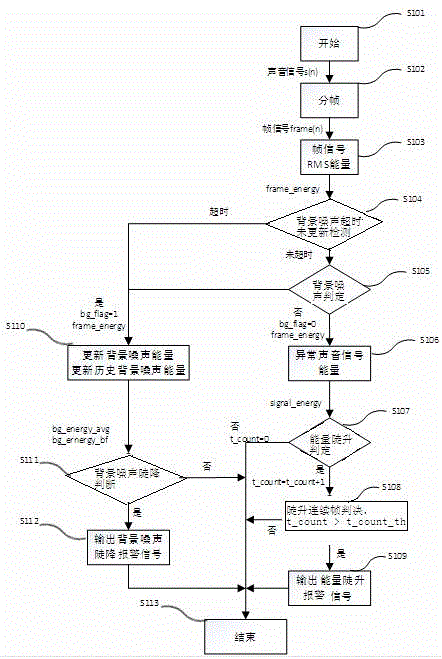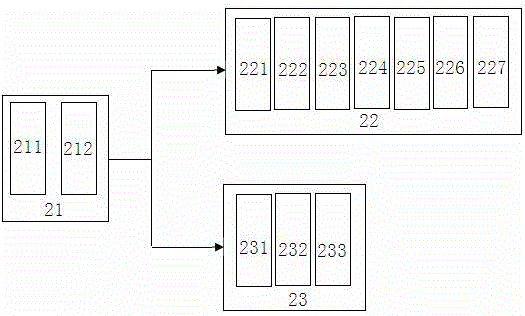Abnormal sound detection method and system of background noise adaption
A background noise and abnormal sound technology, applied in speech analysis, instruments, etc., can solve the problems of high complexity, high integration difficulty, unpredictable abnormal sound, etc., and achieve the effect of small calculation amount and low complexity
- Summary
- Abstract
- Description
- Claims
- Application Information
AI Technical Summary
Problems solved by technology
Method used
Image
Examples
Embodiment 1
[0093] The present invention mainly consists of three parts, a general module 21 , a sudden energy rise detection module 22 , and a background noise steep drop detection module 23 . All modules are processed in the time domain without involving frequency domain transformation, with relatively low complexity and fast operation speed.
[0094] The general module 21 includes a framing module 211 and a frame signal RMS energy module 212
[0095] Framing module 211: the sound signal s(n) includes a speech signal, and since the speech signal has a short-term stability of 10ms-30ms, the frame is divided according to the short-term stationarity of the speech signal, and the signal after framing is frame(n), because The processing is completely time-domain energy processing, so it is enough to use a rectangular window to divide the frame. The frame length is N, and the framed signal is frame(n).
[0096] Frame signal RMS energy module 212: Calculate the RMS value of a frame signal, b...
Embodiment 2
[0137] The specific steps of the abnormal sound detection method of the abnormal sound detection system adaptive to background noise in this embodiment are as follows:
[0138] The sampling rate is 11.025 kHz, 8bit quantization, and the sound signal frame length is 10ms, that is, 110 sampling points.
[0139] S101: Usually, audio stream data s(n) is obtained in this step; the next step is to execute S102.
[0140] S102: Frame division, using 10ms as the frame length, frame shift as 0, just use a rectangular window to divide the frame, N=110 as the frame length, and the signal after framing is frame(n).
[0141] The next step is to execute S103.
[0142] S103: frame signal RMS energy, calculate the RMS value of a frame signal, by calculating the RMS excitation average value of the frame signal frame(n), normalize on the number of quantization bits, and take the logarithm, the frame signal RMS energy can be obtained, Denote it as frame_energy.
[0143] In this embodiment, the...
Embodiment 3
[0166] The specific steps of the abnormal sound detection method of the abnormal sound detection system adaptive to background noise in this embodiment are as follows:
[0167] The sampling rate is 8kHz, 24bit quantization, and the sound signal frame length is 30ms, that is, 240 sampling points.
[0168] S101: Usually, audio stream data s(n) is obtained in this step; the next step is to execute S102.
[0169] S102: Framing, using 30ms as the frame length, frame shift as 0, and using a rectangular window to divide the frame, N=240 as the frame length, and the signal after framing is frame(n).
[0170] The next step is to execute S103.
[0171]S103: frame signal RMS energy, calculate the RMS value of a frame signal, by calculating the RMS excitation average value of the frame signal frame(n), normalize on the number of quantization bits, and take the logarithm, the frame signal RMS energy can be obtained, Denote it as frame_energy.
[0172] In this embodiment, the number of d...
PUM
 Login to View More
Login to View More Abstract
Description
Claims
Application Information
 Login to View More
Login to View More - R&D
- Intellectual Property
- Life Sciences
- Materials
- Tech Scout
- Unparalleled Data Quality
- Higher Quality Content
- 60% Fewer Hallucinations
Browse by: Latest US Patents, China's latest patents, Technical Efficacy Thesaurus, Application Domain, Technology Topic, Popular Technical Reports.
© 2025 PatSnap. All rights reserved.Legal|Privacy policy|Modern Slavery Act Transparency Statement|Sitemap|About US| Contact US: help@patsnap.com


